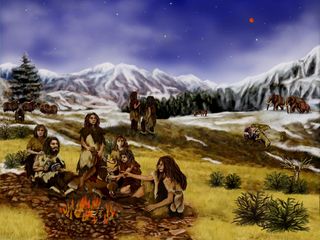It Took Humans Many Chilly Millennia to Master Fire

Early humans may have moved north into the chilly latitudes of Europe hundreds of thousands of years before mastering a crucial technology: Fire.
A survey of 141 archaeological sites in Europe found no evidence of habitual use of fire prior to about 400,000 years ago. Early humans arrived much earlier. Some archeological evidence indicates they arrived in southern Europe more than a million years ago, and the Happisburgh site in the northeastern part of England's Norfolk region contains stone tools dating back more than 800,000 years ago.
Evidence for the use of fire – concentrations of ashes and charcoal, sediments reddened by heat, rocks scarred by heat and burned bones – is nonexistent in Europe until around 400,000 years ago, write the researchers Wil Roebroeks of Leiden University in The Netherlands and Paola Villa of the University of Colorado Museum in Boulder.
The earliest possible evidence of fire comes from two sites that date back to that time, they write. These are located in Schöningen, Germany (where heated stone and charred wood, including a wooden tool, have been found) and the Beeches Pit in England (where archaeologists have uncovered evidence of ancient fireplaces). The sites containing strong evidence of fire, 119 total, are all believed to have been occupied by Neanderthals.
The researchers' conclusion is controversial, because others have put early humans' mastery of fire earlier in our history, as long ago as 2 million years. What's more, fire is widely thought to have made the transition northward — into areas where the temperature dropped below freezing — possible.
Richard Wrangham, of Harvard University, has argued that by making cooking possible, the use of fire allowed our ancestors to evolve larger, more calorie-hungry brains and bodies, and smaller guts suited for more easily digested food.
When it comes to the timing of human mastery of fire, there is a conflict between archaeological and biological evidence, Wrangham said in a statement. "So either way we have a lovely puzzle."
Sign up for the Live Science daily newsletter now
Get the world’s most fascinating discoveries delivered straight to your inbox.
If the archaeological evidence points in the right direction, it's unclear how modern human ancestors eked out a living during lean times and why the arrival of cooking about 400,000 years ago had, at most, trivial effects on our anatomy. "Or the biology is right, in which case we have the puzzle of why some early human occupations show no evidence for the control of fire," he wrote.
The research also reveals Neanderthals employed fire more frequently than thought. These stocky early humans, appeared in Europe more than 400,000 years ago and disappeared about 30,000 years ago. Anatomically modern humans coexisted with Neanderthals, and genomic research has shown that we carry some of their DNA.
"We were able to find there are many more Neanderthal sites that have evidence of fire than most people believed," Villa said. "It proves for them, it was an important technology."
The sites with good evidence of fire include: Portugal, Spain, France, England, Belgium, Italy, Switzerland, Greece, Germany, Poland, Czech Republic, Romania, Croatia, Slovenia, Crimea, Ukraine. The 19 sites older than 400,000 years that lacked evidence of fire were located in Spain, Italy, France, England, Bulgaria and Germany.
Outside of Europe, evidence is sparser. Gesher Benot Ya'aqov in Israel, a site dating to about 780,000 years ago, contains evidence of what appears to be habitual fire use, but there is no evidence that this behavior was transmitted to early humans Europe. Several even older sites in Africa contain traces of fire that the study researchers believe is evidence of opportunistic use of natural fires, rather than habitual use, according to Roebroeks and Villa.
You can follow LiveScience writer Wynne Parry on Twitter @Wynne_Parry.
Most Popular



